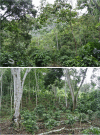Ecological quality as a coffee quality enhancer. A review
- PMID: 36748099
- PMCID: PMC9894527
- DOI: 10.1007/s13593-023-00874-z
Ecological quality as a coffee quality enhancer. A review
Abstract
As both coffee quality and sustainability become increasingly important, there is growing interest in understanding how ecological quality affects coffee quality. Here we analyze, for the first time, the state of evidence that ecological quality, in terms of biodiversity and ecosystem functions, impacts the quality of Coffea arabica and C. canephora, based on 78 studies. The following ecosystem functions were included: pollination; weed, disease, and pest control; water and soil fertility regulation. Biodiversity was described by the presence, percentage, and diversity of shade trees. Coffee quality was described by the green bean physical characteristics, biochemical compounds, and organoleptic characteristics. The presence and diversity of shade trees positively impacted bean size and weight and reduced the percentage of rejected beans, but these observations were not consistent over different altitudes. In fact, little is known about the diversity of shade trees and their influence on biochemical compounds. All biochemical compounds varied with the presence of shade, percentage of shade, and elevation. Coffee beans from more diverse tree shade plantations obtained higher scores for final total organoleptic quality than simplified tree shade and unshaded plantations. Decreasing ecological quality diminished ecosystem functions such as pollination, which in turn negatively affected bean quality. Shade affected pests and diseases in different ways, but weeds were reduced. High soil quality positively affected coffee quality. Shade improved the water use efficiency, such that coffee plants were not water stressed and coffee quality was improved. While knowledge on the influence of shade trees on overall coffee quality remains scarce, there is evidence that agroecosystem simplification is negatively correlated with coffee quality. Given global concerns about biodiversity and habitat loss, we recommend that the overall definition of coffee quality include measures of ecological quality, although these aspects are not always detectable in certain coffee quality characteristics or the final cup.
Keywords: Agroforestry; Biochemical compounds; Biodiversity; Coffea; Ecosystem functions; Final cup; Organoleptic characteristics; Physical characteristics; Shade tree diversity.
© INRAE and Springer-Verlag France SAS, part of Springer Nature 2023, Springer Nature or its licensor (e.g. a society or other partner) holds exclusive rights to this article under a publishing agreement with the author(s) or other rightsholder(s); author self-archiving of the accepted manuscript version of this article is solely governed by the terms of such publishing agreement and applicable law.
Conflict of interest statement
Conflict of interestThe authors declare no competing interests.
Figures



Similar articles
-
Fungal diversity in shade-coffee plantations in Soconusco, Mexico.PeerJ. 2022 Jun 29;10:e13610. doi: 10.7717/peerj.13610. eCollection 2022. PeerJ. 2022. PMID: 35789660 Free PMC article.
-
Shade trees have higher impact on soil nutrient availability and food web in organic than conventional coffee agroforestry.Sci Total Environ. 2019 Feb 1;649:1065-1074. doi: 10.1016/j.scitotenv.2018.08.291. Epub 2018 Aug 25. Sci Total Environ. 2019. PMID: 30308878
-
Effect of shading on yield, sugar content, phenolic acids and antioxidant property of coffee beans (Coffea Arabica L. cv. Catimor) harvested from north-eastern Thailand.J Sci Food Agric. 2012 Jul;92(9):1956-63. doi: 10.1002/jsfa.5568. Epub 2012 Jan 18. J Sci Food Agric. 2012. PMID: 22252511
-
Transformation of coffee-growing landscapes across Latin America. A review.Agron Sustain Dev. 2021;41(5):62. doi: 10.1007/s13593-021-00712-0. Epub 2021 Aug 31. Agron Sustain Dev. 2021. PMID: 34484434 Free PMC article. Review.
-
Coffee berry and green bean chemistry - Opportunities for improving cup quality and crop circularity.Food Res Int. 2022 Jan;151:110825. doi: 10.1016/j.foodres.2021.110825. Epub 2021 Nov 26. Food Res Int. 2022. PMID: 34980376 Review.
Cited by
-
Metabolomic insights into the Arabica-like flavour of stenophylla coffee and the chemistry of quality coffee.NPJ Sci Food. 2025 Mar 19;9(1):33. doi: 10.1038/s41538-025-00398-8. NPJ Sci Food. 2025. PMID: 40108189 Free PMC article.
-
Trade-off between pollinator-wildflower diversity & grassland yields.NPJ Biodivers. 2025 Jan 20;4(1):1. doi: 10.1038/s44185-024-00070-6. NPJ Biodivers. 2025. PMID: 39833499 Free PMC article.
References
-
- Aguilar V, Staver C, Milberg P. Weed vegetation response to chemical and manual selective ground cover management in a shaded coffee plantation. Weed Res. 2003;43:68–75. doi: 10.1046/j.1365-3180.2003.00318.x. - DOI
-
- Allinne C, Savary S, Avelino J. Delicate balance between pest and disease injuries, yield performance, and other ecosystem services in the complex coffee-based systems of Costa Rica. Agric Ecosyst Environ. 2016;222:1–12. doi: 10.1016/j.agee.2016.02.001. - DOI
-
- Alpizar E, Vaast P, Bertrand B. Proceedings of 20th International Conference on Coffee Science. India: Bangalore; 2005. Fat content: a quality indicator for Central America coffee? pp. 1074–1076.
-
- Alves AL, Pessoa MS, de Souza PEN, et al. Influence of environmental and microclimate factors on the coffee beans quality (C. canephora): correlation between chemical analysis and stable free radicals. Agric Sci. 2018;09:1173–1187. doi: 10.4236/as.2018.99082. - DOI
-
- Angermeier P, Karr J. Ecosystem Management. New York, NY: Springer; 1994. Biological integrity versus biological diversity as policy directives: protecting biotic resources; pp. 264–275.
Publication types
LinkOut - more resources
Full Text Sources
Research Materials
